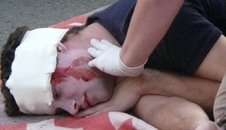Bleeding can be life threatening so
Find First Aid for Bleeding Info Here...

If you want First Aid for Bleeding Info on any of the below links click on them to go to the specific page.
But if you want to understand more about bleeding, bloods appearance, components and functions continue reading till the end of this page.
- First Aid Severe Bleeding - External
- First Aid for Uncontrolled Severe Bleeding
- First Aid for Internal Bleeding
- First Aid for Nosebleeds
- First Aid for Cuts and Scrapes
IMPORTANT NOTE: the likelihood of shock occurring with severe blood loss is high. So if you need to go straight to First Aid for Shock than click here.
Bloods appearance, function and components
Having an understanding of bloods appearance, function and components can help with making a good assessment when giving First Aid for bleeding so here is some important info...
Blood appearance is different depending on whether it is coming from arteries, veins or capillaries.
Arterial bleeding:-
- is bright red (although it darkens when it meets the air)
- usually spurts with each heart beat
- usually severe and hard to control
Venus bleeding:-
- dark red to maroon in colour
- is more steady in flow
Capillary bleeding is:-
- red in colour
- usually slow more like an ooze
Basic components of blood
Red blood cells - contain haemoglobin that carry oxygen around the body. It is the iron in the haemoglobin that gives blood its red colour. When the blood goes from the heart to the lungs the haemoglobin molecules bind with the oxygen in the lungs. After the blood passes through the lungs it briefly returns to the heart to be pumped to the rest of the body delivering the oxygen to the rest of the body's cells.
White blood cells - the main function is to fight and remove disease from the blood. Some types of white cells eat both harmful bacteria and the damaged and dead cells that naturally occur during the life cycle of the body.
Platelets - are responsible for blood clotting. When platelets are exposed to air during bleeding they are involved in a process that creates a long stringy substance that mats together to create clotting. This blocks or "clogs up" the wound with the intention of preventing blood from escaping.
Plasma - a yellowish watery fluid that is left after the red blood cells, white blood cells and platelets are removed. Plasma dissolves various substances like sugar, food, minerals, waste products etc for transport around the body.
Three Main Functions of Blood
- Transporting oxygen, nutrients and waste around the body
- Assisting in the maintenance of optimum body core temperature
- Transporting cells that are to defend against germs, assist with clotting and assist in the process of healing
I hope you have found our information on first aid for bleeding and the bloods appearance, function and components helpful.
Now you may want to learn what to do for First Aid for Severe Bleeding...
Or see how to give First Aid for Internal Bleeding...
Maybe you have a nosebleed and need First Aid info NOW...